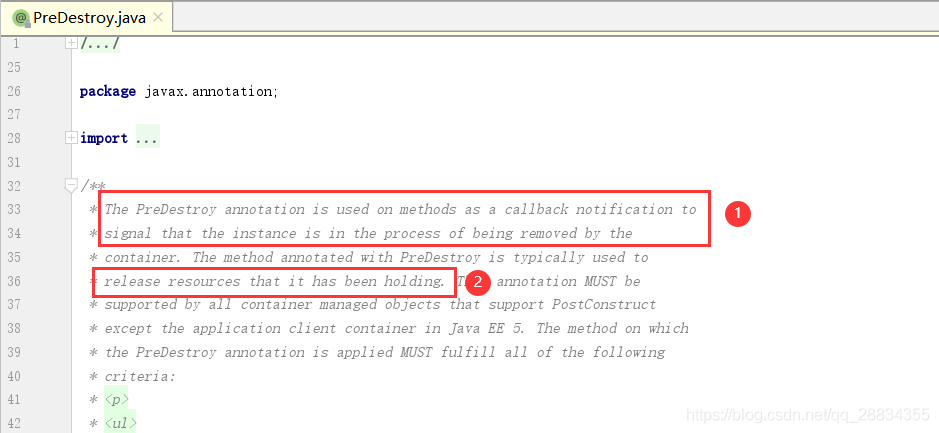SpringBoot @PostConstruct和@PreDestroy的使用说明
作者:°Fuhb
1. @PostConstruct
1.1 概述
@PostConstruct标记在方法上,在当前类的实例加入到容器之前,会先执行@PostConstruct标记的方法。它的执行顺序是这样的:
- 先执行当前类的构造函数
- 然后执行@Autowired标记对象的初始化
- 最后执行@PostConstruct标记的方法
- 如果没有抛出异常,则该对象加入Spring管理容器
1.2 验证执行顺序
创建一个空的Spring Boot项目,这步不演示了
创建TestComponent
@Component
public class TestComponent {
public TestComponent(){
System.out.println("TestComponent 构造函数");
}
@PostConstruct
public void init(){
System.out.println("TestComponent PostConstruct");
}
}
创建MyService
public interface MyService {
void Hello(String name);
}
创建MyServiceImpl
@Service
public class MyServiceImpl implements MyService {
public MyServiceImpl(){
System.out.println("MyServiceImpl 构造函数");
}
@PostConstruct
public void init(){
System.out.println("MyServiceImpl PostConstruct");
}
@Override
public void Hello(String name) {
System.out.println("Hello " + name);
}
}
运行项目,看下输出结果。
TestComponent和MyServiceImpl分别独自初始化,构造函数优先执行
请记住这个执行顺序
TestComponent 构造函数
TestComponent PostConstruct
MyServiceImpl 构造函数
MyServiceImpl PostConstruct
还没完,改一下TestComponent,加入引用MyService
@Autowired
private MyService myService;
再执行一下,看看结果有什么变化
TestComponent 构造函数
MyServiceImpl 构造函数
MyServiceImpl PostConstruct
TestComponent PostConstruct
MyServiceImpl执行顺序往前移动了,证明@Autowired顺序在@PostConstruct之前
因此,如果要在TestComponent初始化的时候调用MyService方法,要写在@PostConstruct内部,不能在构造函数处理(这时候MyServiceImpl还没初始化,会抛出空指针异常)
@Component
public class TestComponent {
@Autowired
private MyService myService;
public TestComponent(){
System.out.println("TestComponent 构造函数");
//写在这里必定抛出异常,此时 myService == null
//myService.Hello("张三");
}
@PostConstruct
public void init(){
System.out.println("TestComponent PostConstruct");
//在这里调用MySerice方法才正确
myService.Hello("张三");
}
}
2. @PreDestroy
首先,来看下Java Doc对这个注解的说明

1: 在对象实例被容器移除的时候,会回调调用@PreDestroy标记的方法
2: 通常用来释放该实例占用的资源
修改上面的TestComponent代码,加上@PreDestroy代码
@PreDestroy
public void destroy(){
System.out.println("TestComponent 对象被销毁了");
}
修改Application main方法,启动10秒后退出程序
@SpringBootApplication
public class AnnotationTestApplication {
public static void main(String[] args) {
ConfigurableApplicationContext ctx = SpringApplication.run(AnnotationTestApplication.class, args);
try {
Thread.sleep(10 * 1000);
} catch (InterruptedException e) {
e.printStackTrace();
}
ctx.close();
}
}
启动程序,查看输出信息
程序退出时会销毁对象,所以会触发我们刚写的@PreDestroy方法,测试通过。

以上为个人经验,希望能给大家一个参考,也希望大家多多支持脚本之家。
您可能感兴趣的文章:
- springboot中@PostConstruct注解使用小结
- SpringBoot中@PostConstruct 注解的实现
- springboot启动加载CommandLineRunner @PostConstruct问题
- SpringBoot中的@PostConstruct注解详细解析
- SpringBoot使用@PostConstruct注解导入配置方式
- springboot @PostConstruct无效的解决
- 浅谈SpringBoot中的Bean初始化方法 @PostConstruct
- SpringBoot @PostConstruct原理用法解析
- SpringBoot中多个PostConstruct注解执行顺序控制
